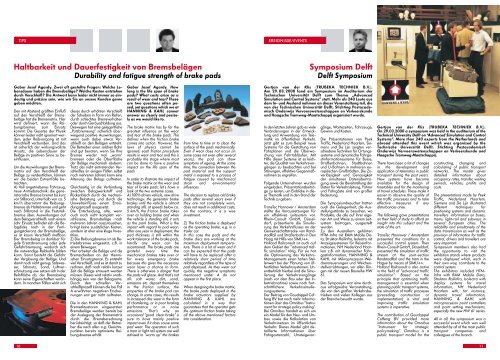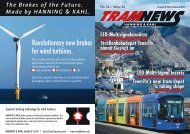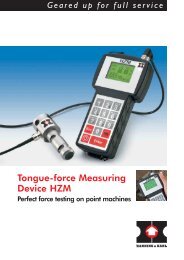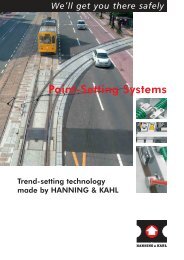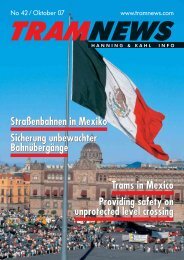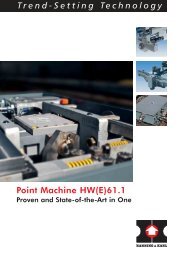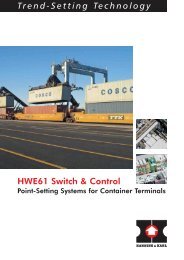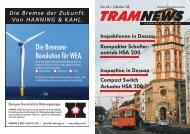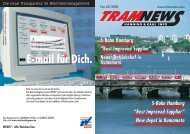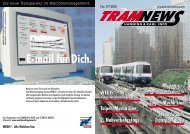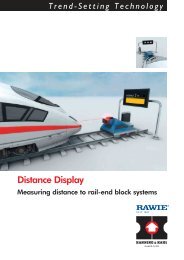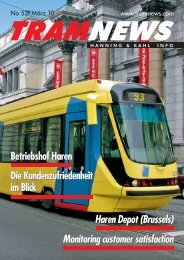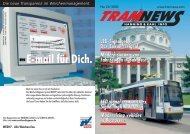Ein Notlösegerät für alle Fälle Gent Prüfung von ... - Hanning & Kahl
Ein Notlösegerät für alle Fälle Gent Prüfung von ... - Hanning & Kahl
Ein Notlösegerät für alle Fälle Gent Prüfung von ... - Hanning & Kahl
Erfolgreiche ePaper selbst erstellen
Machen Sie aus Ihren PDF Publikationen ein blätterbares Flipbook mit unserer einzigartigen Google optimierten e-Paper Software.
TIPS<br />
EREIGNISSE/EVENTS<br />
Haltbarkeit und Dauerfestigkeit <strong>von</strong> Bremsbelägen<br />
Durability and fatigue strength of brake pads<br />
Symposium Delft<br />
Delft Symposium<br />
Gabor Josef Agardy. Zwei oft gestellte Fragen: Welche Lebensdauer<br />
haben die Bremsbeläge Welche Kosten entstehen<br />
durch Verschleiß Die Antwort kann leider nicht immer so eindeutig<br />
und präzise sein, wie wir Sie an unsere Kunden gerne<br />
geben möchten.<br />
Den mit Abstand größten <strong>Ein</strong>fluß<br />
auf den Verschleiß der Bremsbeläge<br />
hat die Bremsmatrix. Hier<br />
wird definiert, wann die Reibungsbremse<br />
zum <strong>Ein</strong>satz<br />
kommt. Die Gesetze der Physik<br />
können leider nicht ignoriert werden:<br />
jeder Reibvorgang ist mit<br />
Verschleiß verbunden. Und das<br />
ist sicherlich der wirkungsvollste<br />
Ansatz, die Lebensdauer der<br />
Beläge im positiven Sinne zu beeinflussen.<br />
Um die Auswirkungen der Bremsmatrix<br />
auf den Verschleiß der<br />
Beläge zu verdeutlichen, können<br />
wir die beiden Extremfälle betrachten.<br />
A) Voll angetriebenes Fahrzeug,<br />
neue Antriebstechnik: die generatorische<br />
Bremse bremst bis kurz<br />
vor Stillstand, unterhalb <strong>von</strong> ca. 5<br />
km/h übernimmt die Reibungsbremse<br />
als Haltebremse und geht<br />
nach Stillstand in die Feststellbremse<br />
über. Auswirkungen auf<br />
dem Belagverschleiß: nach einem<br />
Jahr <strong>Ein</strong>satz befindet sich die Belagdicke<br />
noch in der Fertigungstoleranz<br />
der Bremsbeläge,<br />
es ist kaum Verschleiß meßbar.<br />
Der Bremsbelag ist dankbar für<br />
jede Ersatzbremsung oder jede<br />
Gefahrbremsung, wodurch sich<br />
die notwendige Reibkohle bilden<br />
kann. Sonst besteht die Gefahr<br />
der Verglasung der Beläge. Und<br />
damit noch nicht genug: Salzwasser,<br />
Schmutz, Sand, Luftverschmutzung<br />
usw. setzen sich in der<br />
Reibfläche ab, der Bremsbelag<br />
kann seine Eigenschaften verändern.<br />
In manchen Fällen wirkt sich<br />
dieses durch erhöhten Verschleiß<br />
der Scheiben in Form <strong>von</strong> Riefen,<br />
durch schlechtes Bremsverhalten<br />
oder durch Geräuschbildung aus.<br />
Deswegen hat eine gelegentliche<br />
„Putzbremsung“ sicherlich überwiegend<br />
positive Auswirkungen,<br />
wenn auch dabei etwas Verschleiß<br />
an den Belägen entsteht.<br />
Die Betreiber einer solchen Bahn<br />
sind gut beraten, wenn Sie Ihre<br />
Bremse wieder mal „warm“<br />
bremsen oder die Oberfläche<br />
der Beläge mechanisch säubern.<br />
Trotz des nicht eintretenden Verschleißes<br />
(in einigen Fällen selbst<br />
nach mehreren Jahren) kann eine<br />
Alterung des Belags auftreten.<br />
Gleichzeitig ist die Verbindung<br />
zwischen Belagwerkstoff und<br />
Rückenblech durch die mechanische<br />
Belastung und durch die<br />
Umwelteinflüsse einem Ermüdungsprozeß<br />
ausgesetzt.<br />
Die Entscheidung, alte, wenn<br />
auch noch nicht komplett verschlissene,<br />
Bremsbeläge nach<br />
mehreren Jahren auszutauschen,<br />
bringt keine zusätzlichen Kosten,<br />
sondern ist eher eine kluge Investition.<br />
Z) Die Reibungsbremse ist als Betriebsbremse<br />
eingesetzt, z.B. in<br />
einem Beiwagen.<br />
Hier arbeiten die Beläge und die<br />
Bremsscheiben an der thermischen<br />
<strong>Ein</strong>satzgrenze. Es entsteht<br />
viel Verschleiß, und es ist damit zu<br />
rechnen, daß nach relativ kurzer<br />
Zeit die Beläge erneuert werden<br />
müssen. Dieses wird relativ unabhängig<br />
sein <strong>von</strong> der Belagsorte.<br />
Durch den schnellen Verschleißprozeß<br />
können die bei Fall<br />
A erwähnten negativen Erscheinungen<br />
erst gar nicht auftreten.<br />
Die in den HANNING & KAHL<br />
Bremsaktuatoren eingesetzten<br />
Bremsbeläge werden bereits bei<br />
der Auslegung der Bremsmatrix<br />
durch die Bremsberechnung<br />
berücksichtigt, so daß der Betreiber<br />
die nach <strong>alle</strong>n o.g. Gesichtspunkten<br />
bereits optimierte Reibungsbremse<br />
erhält.<br />
Gabor Josef Agardy. How<br />
long is the life span of brake<br />
pads What costs arise as a<br />
result of wear and tear These<br />
are two questions often posed,<br />
yet questions which we at<br />
HANNING & KAHL cannot<br />
answer as clearly and pecisely<br />
as we would like to.<br />
The brake matrix has by far the<br />
greatest influence on the wear<br />
and tear of the brake pads. This<br />
defines when the friction brake<br />
comes into action. However, the<br />
laws of physics cannot be<br />
ignored: each friction procedure<br />
results in wear and tear and this is<br />
probably the stage where most<br />
can be done to have a positive<br />
impact on the life span of the<br />
pads<br />
In order to illustrate the impact of<br />
the brake matrix on the wear and<br />
tear of brake pads, let’s have a<br />
look at the two extreme cases.<br />
A) 100% driven vehicle, new drive<br />
technology: the generator brake<br />
brakes until the vehicle is almost<br />
standing still, at speeds below ca.<br />
5 km/h, the friction brake takes<br />
over as holding brake and when<br />
the vehicle is standing still, it acts<br />
as the park brake. What is the<br />
impact with regard to pad wear:<br />
after one year in deployment, the<br />
pad thickness is still within the<br />
work tolerance of the brake pads,<br />
hardly any wear can be<br />
ascertained. The brake pads are<br />
grateful every time the<br />
mechanical brakes take over or<br />
for every emergency brake<br />
because this gives the necessary<br />
wear layer a chance to form.<br />
There is otherwise a danger that<br />
the pads will glaze. And that’s not<br />
all: salt water, dirt, sand,<br />
emissions etc. deposit themselves<br />
in the friction surface, the<br />
properties of the brake pad can<br />
change. In some cases, this results<br />
in increased disc wear in the form<br />
of chamfering, or in poor braking<br />
performance or in noise<br />
emissions. That’s why an<br />
occasional “good clean brake“ is<br />
sure to have mainly positive<br />
impact even if it does cause some<br />
pad wear. The operators of such<br />
a tram or light rail system are well<br />
advised to “warm up“ the brakes<br />
from time to time or to clean the<br />
surface of the pads mechanically.<br />
Even if wear does not occur (in<br />
some cases not even after several<br />
years), the pad can show<br />
symptoms of ageing. At the same<br />
time, the connection between the<br />
pad material and the support<br />
metal is exposed to a process of<br />
fatigue caused by mechanical<br />
strain and environmental<br />
influences.<br />
The decision to replace old brake<br />
pads after several years even if<br />
they are not completely worn,<br />
does not result in additional costs,<br />
on the contrary, it is a wise<br />
investment.<br />
Z) The friction brake is deployed<br />
as the operating brake, e.g. in a<br />
trailer car.<br />
In this case the pads and the<br />
brake discs are working at the<br />
maximum deployment temperature.<br />
There is a lot of wear and it<br />
can be expected that the pads<br />
will have to be replaced after a<br />
relatively short period of time<br />
relatively regardless of the type of<br />
pad deployed. As they wear out<br />
quickly, the negative symptoms<br />
mentioned under A do not<br />
appear in the first place.<br />
When designing the brake matrix,<br />
the brake pads deployed in the<br />
brake actuators supplied by<br />
HANNING & KAHL are<br />
calculated in a way that<br />
guarantees that the operator gets<br />
the optimum friction brake taking<br />
all the above-mentioned factors<br />
into consideration.<br />
Gertjan van der Klis (TRUBEKA TECHNIEK B.V.).<br />
Am 29. 03. 2000 fand ein Symposium im Auditorium der<br />
Technischen Universität Delft zum Thema „Advanced<br />
Simulation and Control Systems” statt. Mehr als 240 Leute aus<br />
dem In- und Ausland nahmen an dieser Veranstaltung teil, die<br />
<strong>von</strong> der Technischen Universität Delft, Stichting Postacademisch<br />
Onderwijs Vervoerswetenschappen en Verkeerskunde<br />
und Haagsche Tramweg-Maatschappij organisiert wurde.<br />
In den letzten Jahren gab es viele<br />
Veränderungen in der Entwicklung<br />
und Anwendung <strong>von</strong> Telematik<br />
im öffentlichen Verkehr.<br />
Jetzt gibt es zum Beispiel neue<br />
Systeme für die Gestaltung <strong>von</strong><br />
Fahrplänen und die Überwachung<br />
<strong>von</strong> Fahrtabläufen. Mit<br />
Hilfe dieser Systeme ist es leichter,<br />
die Qualität <strong>von</strong> Verkehrsvorgängen<br />
zu beobachten und bei<br />
Störungen, effektive Gegenmaßnahmen<br />
zu ergreifen.<br />
Folgende Unternehmen wurden<br />
eingeladen, Präsentationsbeiträge<br />
zu leisten, um <strong>Ein</strong>blicke in diese<br />
Thematik und in den Stand der<br />
Technik zu geben:<br />
TransTec Hannover / Amsterdam<br />
stellte die Voraussetzungen für<br />
ein effektives Leitsystem vor.<br />
Rhein-Consult GmbH, Düsseldorf,<br />
präsentierte die Simulierung<br />
des Verkehrsflusses an der<br />
Gemeinsschaftstrecke <strong>von</strong> RandstadRail<br />
und Straßenbahn in Den<br />
Haag mit Hilfe <strong>von</strong> SIMU++.<br />
Holland Railconsult ist auch auf<br />
dem Gebiet der "advanced traffic<br />
simulation” tätig. Für sie hat<br />
die Optimierung des Verkehrs-<br />
Managements einen hohen Stellenwert<br />
bei der Planung <strong>von</strong> öffentlichen<br />
Verkehrssystemen. Unentbehrlich<br />
hierbei sind die Simulierung<br />
der Verkehrsvorgänge<br />
(noch vor dem Bau oder der Inbetriebnahme)<br />
sowie noch fortschrittlichere<br />
Verkehrssimulierungssysteme.<br />
Der Beitrag <strong>von</strong> Goudappel Coffeng<br />
BV bot noch mehr Informationen<br />
über das Omnibus "Instrument<br />
for strategic policy making”.<br />
Bei Omnibus handelt es sich um<br />
ein Model für den Neu- und Umbau<br />
sowie die Kalkulation <strong>von</strong><br />
Verkehrsnetzen im öffentlichen<br />
Verkehr. Dieses Model gibt detaillierte<br />
Informationen über<br />
Fahrgastanzahl, Umsteigevorgänge,<br />
Wartezeiten, Fahrzeuge,<br />
Gewinn und Kosten.<br />
Die Präsentationen <strong>von</strong> Peek<br />
Traffic, Nederland Haarlem, Siemens<br />
und De Lijn zeigten verschiedene<br />
Techniken für Ortungssysteme<br />
und dynamische Fahrgastinformationsysteme<br />
für Busse,<br />
Straßenbahnen, Stadtbahnen<br />
und U-Bahnen in mehreren europäischen<br />
Großstädten. Die Zuverlässigkeit<br />
und Genauigkeit<br />
der simultanen Datenübertragung<br />
sowie die Bereitstellung der<br />
Daten für Verkehrsleitung, Fahrer<br />
und Fahrgäste sind <strong>von</strong> großer<br />
Bedeutung.<br />
Die Symposiumbesucher hatten<br />
auch die Gelegenheit, die Ausstellungsstände<br />
zu besuchen, wo<br />
Produkte, die <strong>alle</strong> auf ihrer eigenen<br />
Art und Weise zu einem Leitsystem<br />
beitragen, ausgestellt<br />
wurden.<br />
Zu den Ausstellern gehörten<br />
HTM-Infra mit RAM Mobile Data,<br />
Strukton Railinfra, Isolectra mit<br />
Anzeigesystemen für Reiseinformationen,<br />
NH Nederland Haarlem<br />
z.B. mit dynamischer Fahrgastinformation,<br />
HANNING &<br />
KAHL mit Mikroprozessor-Weichensteuerungen<br />
und Weichenstellvorrichtungen,<br />
vor <strong>alle</strong>n Dingen<br />
mit der neuen Baureihe HW<br />
61.<br />
Das Symposium war eine durchaus<br />
erfolgreiche Veranstaltung,<br />
die <strong>von</strong> den großen Verkehrsbetrieben<br />
und vielen Kollegen aus<br />
der Branche besucht wurde.<br />
Gertjan van der Klis (TRUBEKA TECHNIEK B.V.).<br />
On 29.03.2000 a symposium was held in the auditorium of the<br />
Technical University Delft on “Advanced Simulation and Control<br />
Systems“. More than 240 experts from the Netherlands and<br />
abroad attended this event which was organized by the<br />
Technische Universität Delft, Stichting Postacademisch<br />
Onderwijs Vervoerswetenschappen en Verkeerskunde and<br />
Haagsche Tramweg-Maatschappij.<br />
There have been a lot of changes<br />
in the development and<br />
application of telematics in public<br />
transport during the past years.<br />
New systems have become<br />
available for the design of<br />
timetables and for the monitoring<br />
of travel schedules. These make it<br />
easier to observe the quality of<br />
the traffic processes and to take<br />
effective measures if any<br />
disturbances arise.<br />
The following gave presentations<br />
on their field of study to afford an<br />
insight into this subject and the<br />
state of the art:<br />
TransTec Hannover / Amsterdam<br />
presented the conditions for a<br />
successful control system. Then<br />
Rhein-Consult GmbH, Düsseldorf,<br />
presented the simulation of traffic<br />
stream at the joint-section<br />
RandstadRail and the tram in the<br />
Hague by means of SIMU++.<br />
Holland Railconsult is also active<br />
in the field of “advanced traffic<br />
simulation“. Based on the<br />
principle that optimising traffic<br />
management is essential when<br />
planning public transport systems,<br />
the simulation of traffic processes<br />
(preceding construction or<br />
implementation) is vital and<br />
improving traffic simulation<br />
systems is imperative.<br />
The contribution of Goudappel<br />
Coffeng BV provided more<br />
information about the Omnibus<br />
“Instrument for strategic<br />
policymaking“. Omnibus is a<br />
public transport model for the<br />
constructing, changing and<br />
calculating of public transport<br />
networks. The model gives<br />
detailed information about<br />
occupancy rates, transfer, waiting<br />
periods, vehicles, profits and<br />
costs.<br />
The presentations made by Peek<br />
Traffic, Nederland Haarlem,<br />
Siemens and De Lijn illustrated<br />
different techniques for<br />
positioning systems and dynamic<br />
travellers’ information on buses,<br />
trams, light-rail and subways in<br />
several European cities. The<br />
reliability and simultaneity of the<br />
data transmission as well as the<br />
provision of information for traffic<br />
control, drivers and travellers are<br />
very important.<br />
Symposium members also had<br />
the opportunity to visit the<br />
exhibition stands where products<br />
were displayed which, each in<br />
their own way, contribute to the<br />
control system.<br />
The exhibitors included HTM-<br />
Infra with RAM Mobile Data,<br />
Strukton Railinfra, Isolectra with<br />
display systems for travel<br />
information, NH Nederland<br />
Haarlem with, for instance,<br />
dynamic travel information,<br />
HANNING & KAHL with<br />
microprocessor point controllers<br />
and point setting mechanisms,<br />
especially the new HW 61 series.<br />
All in all, the symposium was a<br />
successful event which was well<br />
attended by all of the main public<br />
transport companies and<br />
colleagues of the branch.<br />
10<br />
11


